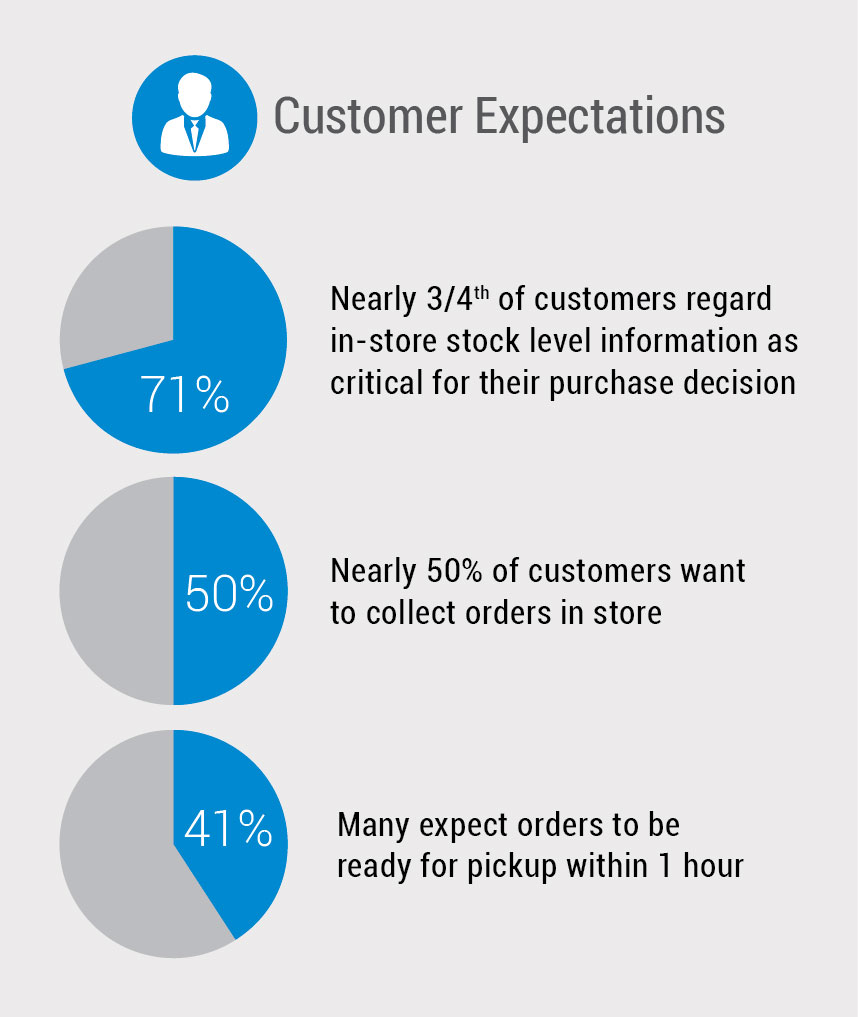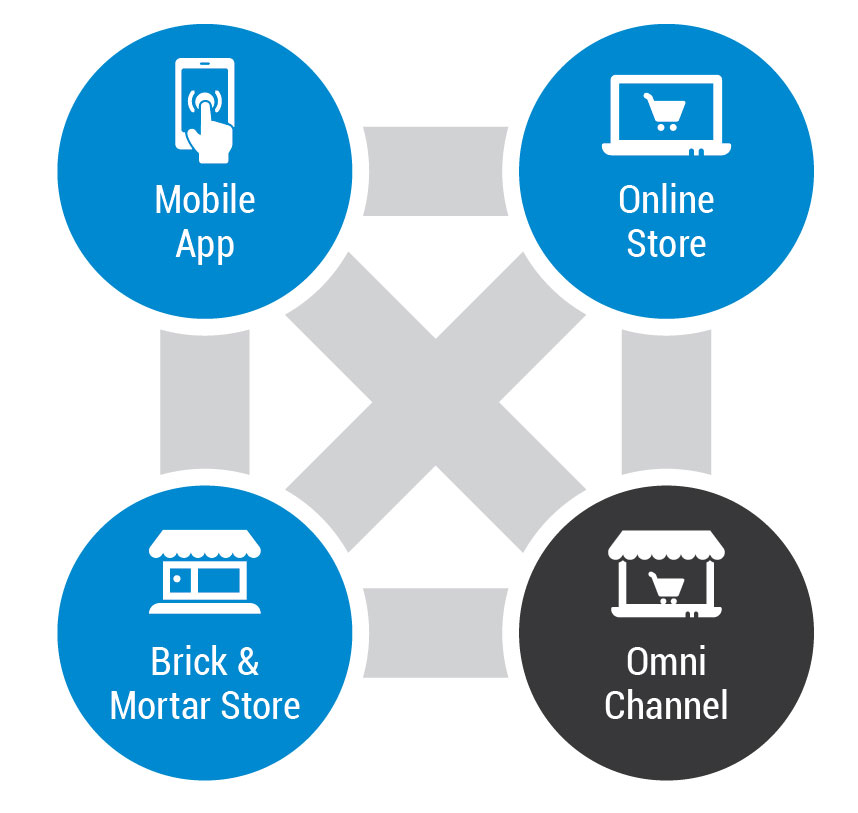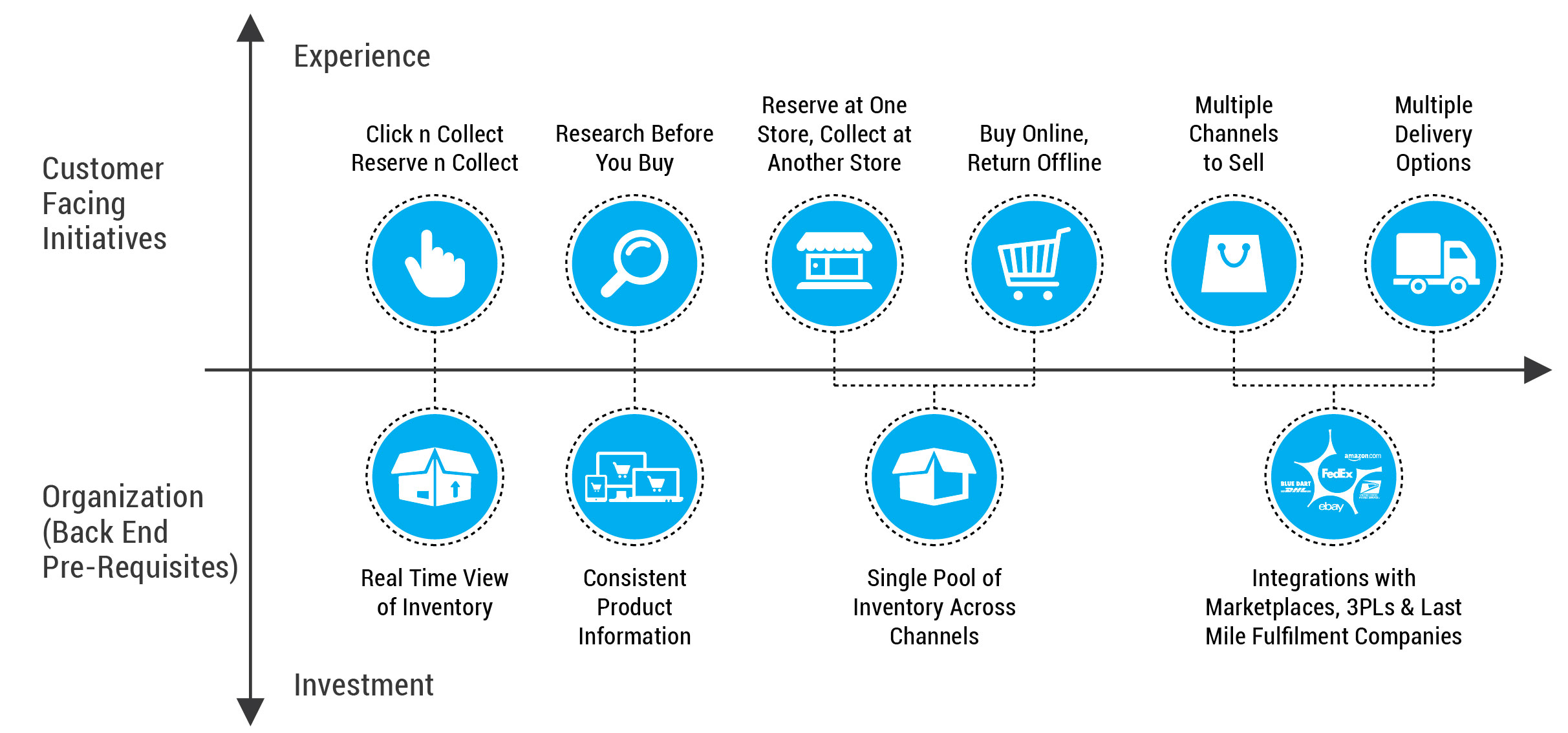The Role of SCM In Retail Scenario of Today
Source: Images Retail
This article was originally featured on Images Retail Magazine (May 2017 edition, Volume 16)
With the retail market growing vigorously, retailers across the nation are ideating on how to make the best of the opportunities at hand. Supply chain management plays a vital role in the entire process.
Importance of Time Definite SCM Service for Retailers
With an all-round boom in the retail sector, the psyche of the consumers is also rapidly evolving. Consumers today, know what they like, go for what they want, and expect impeccable services. This consumer evolution has stirred the retail sector and to keep up with the pace; retailers are coming up with ways to minimize the operational cost as much as they can, without hampering the quality of the product, time management and keeping up with the demand forecasting.
Providing the right product at the right time is the need of the hour. Management of the transition of products from manufacturing to the point-of-sales is key. Achieving this by itself would ensure the smooth functioning of any retail organization. From the planning of inventory, transition of products and the point of sales, SCM deals with the proper control of it all. A slight shift for the worse to any of the processes in the supply chain could cause dissatisfaction of consumers and lead to major risks in business.
“Availability of stock on shelves is the single largest success factor for a retail business. Timely delivery of products and faster replenishment requires time bound logistic services. Time-definite logistic service is critical for any grocery retail business, particular dairy and F&V sectors, but not so critical for apparel retail business,” Mahesh Khetan, Asst Vice President – Supply Chain Management, Aditya Birla Fashion and Retail Ltd – Pantaloons.
He further adds, “With e-commerce and omnichannel players competing in the marketplace, retailers are indeed getting more and more conscious of time-definite logistic service.” Ranjan Sharma, Head IT and Supply Chain, Bestseller Retail India Pvt Ltd, says, “We have weekly new launches and the entire supply chain is geared to meet those dates as a lot of planning is involved in it and any misses cost us heavily.”
With SCM in place, the retailer is able to monetise on new and upcoming trends with a faster pace and avoid the other risks usually faced.
Revising the Supply Chain Practices in Omnichannel Era
The consumer today is driving the need for transformation in omnichannel retail supply chains. The buyers have all the power in today’s market. They are demanding more options and leveraging retailers against each other to get the best value for their money. A competitive retail environment is leading retailers to opt for an omnichannel strategy. Retailers are working towards seamlessly integrating their distribution channels to improve visibility into inventory and serve their customers in a better way.
The mechanics of logistics is constantly evolving and today as the world is more connected than ever, there is a need for real-time integration across channels. Resonating the same fact, P. C. Sharma, CEO, and Whole Time Director, TCIExpress, says, “ At TCIExpress we are constantly tracking the movement of goods on a real time basis and we also look at online response management (ORM) as a critical mechanism to address the consumer through the social network. We have uniformly deployed content across platforms such as our website, catalogues, brochures, Facebook page, Twitter and LinkedIn, to ensure common messaging.”
The path to purchase is becoming more complex amidst the ever-burgeoning growth of online and mobile shopping. According to Zebra’s 2017 Retail Vision Study (RVS), superior omnichannel support requires 90% inventory accuracy. As a result, inventory accuracy is more critical than ever as products from both brick-and-mortar and digital channels flow through the pipeline. Talking about the same, Deep Agarwal, Regional Sales Director – India, Zebra Technologies, “Omnichannel retailing has become a necessity more than a requirement as consumers today are digitally empowered. Consumers can virtually tap into every retailer’s stockroom from their mobile device to search for products and compare prices. To meet this demand, retailers are adopting technology solutions to heighten merchandise visibility throughout the supply chain, from the time inventory, is shipped from the warehouse and received in a store’s back room to when it’s stocked and replenished on the sales floor.
Agarwal, adds, “The rise of online shopping has trained consumers to demand unprecedented convenience. Retailers today, must be nimble enough to serve their multichannel shopping journeys seamlessly. Around the globe, retailers are investing in IoT technologies to redefine their operations and the shopper experience. Merchants are reinventing their supply chains with upgrades that enable automated, real-time inventory visibility via Internet of Things (IoT), such as RFID, which can boost inventory accuracy levels to as high as 95%.”
Talking from an eCommerce perspective, Venkat Nott, CEO, Vinculum, says, “Customers today do not like to wait for the products they buy. However, most of them do not like to pay more for express service. A paid service for fast shipments is likely to work well for Retailers. Marketplaces have set the standard already and have invested in products not just to streamline their order management processes and to have real time inventory in stores and warehouses but also predictive analytics in terms of what products to carry in which store and keeping the right products in warehouses close to the buyer.”
Further talking about Vinculum services, he says, “Vinculum has cutting edge products to facilitate OmniChannel retailing and provides a real-time view of inventory across the supply chain using our Vin eRetail suite of products.”
Retailer’s Perspective on Omnichannel Retail is going omnichannel and meeting the supply chain
needs of this new environment is a major challenge. Talking on this aspect, Chugh of Raymond says, “ Yes, it’s true that retail is going Omnichannel and meeting the needs of this new environment is a big challenge. Since this is the need of the hour & must be implemented to get the better sales. We are also working on this but at a very initial stage as of now.” Khetan, says, “If you cannot beat them, join them!
Omnichannel is the future and no retail organization can stay away from entering into it. We have started selling online through prominent e-Commerce players like Amazon, Flipkart etc, in addition to creating our own omnichannel platform.”
“We are going through a lot of technology intervention which includes bringing together different portals and marketplaces to converge to one system at the store for execution with real-time integration of inventory and logistics. We have already gone live across all our stores for Tata Cliq since 1st October 2016 and will be live on our brand websites by the end of June,” says, Sharma, from Bestseller.
Forecasting Techniques and Methodologies
Traditionally, retailers have not been able to predict the demand, leading to a mismatch between demand and supply, thereby affecting profitability. Even though forecasting techniques and methodology have continued to develop in sophistication, they cannot deliver the accuracy required for managing logistics in the context of the retail scenario.
The answer to these problems lies not in better forecasts, but in reducing the dependency on the forecast and by harnessing the potential of modern logistics services. Talking about the same, Sharma from Bestseller, says, “We are fast fashion brands and we have to spot trend way ahead of time. Then we get into sampling and manufacturing cycle which is also very long.
Though modern logistic services definitely help to reduce the overall time to make the merchandise available, however, the same cannot replace the art of demand forecasting. At the same time if the entire sourcing strategy and manufacturing is aligned well then smaller sample sets could be developed and on their success, large-scale manufacturing could be done thus reducing the risk.” Chugh, opines, “Answer to these supply chain related problem lies not in better forecasts, but in reducing the dependency on the forecast and by harnessing the potential of modern logistics services.”
Innovations that Inextricably Links SCM & Retail
Talking about the innovations that is happening in the space of supply chain management, Kanaujia, says, “Emerging trends like making the supply chains digital, increasing the role of procurement in supply chain, increasing collaboration for efficient supply chain management, etc., will be the major factors driving growth in the organised retail market in India. Being the industry leader, our role is very vital in bringing about the global standards to India. We are proactively working towards hastening this change in our industry and taking it to a different level.” Future Supply Chain Solutions Limited has recently inaugurated a High-Speed Cross Belt Sortation Technology, at its Distribution Centre Mihan, Nagpur.
This new technology, being first of its kind in India, is touted to be a game changer and a stepping stone, making it India’s most automated first-of-its-kind Talking about this new innovative SCM facility, Kishore Biyani, Group CEO, Future Group says, “This distribution center will be a milestone in the Indian warehousing sector. With the brilliant technology used in the Sorting system at the DC along with the individually coordinated system solutions, we can ensure the highest level of service to the Consumers of the Nation.”
Talking about some of the SCM best practices adoption, Khetan, says, “There had been quite a few best SCM practices adopted by us, key ones being: use of warehouse management system (WMS) coupled with RFID technology turning our warehouses into paperless operation, Auto replenishment system (ARS), ensuring faster replenishment of stock to the stores and Vendor portal for auto approvals of shipment requests from vendor. Divulging the details of SCM innovative practices that has helped Raymond in staying ahead in the game, Chugh, says, “Layout restructuring, current season stock kept on ground floor & previous season stock moved to 1st & 2nd floors based on the aging. This helped us in increasing picking productivity; manpower deployment based on season/month wise load helped us in cost reduction of WH transactions/piece; working on Auto LSP selection program which help us in significant reduction of the logistics cost/piece; manual processes converted to system based programs which helped in hassle and error free work.”
Keeping Business Seamless Even During Peak Seasons
Managing fluctuations in demand during peak and seasonal requirements is a must for every retailer. Talking about the same, Khetan, says, “There is a separate forecast for peak and seasonal requirement which is aligned with capacities at each node of the supply chain, right from transporters’ hubs to warehouse capacities for the transaction as well as storage.”
“We start building up stock at the DC and retail points well in advance so as to reduce the spike in demand. We also cross-train people to handle loads during peak seasons in multiple shifts,” says, Sharma from Bestseller.
A lot of automation devices/equipment are being used in International SCM industry which reduces the dependency on labour. It helps on improving the productivity as well as reduction of manual errors. Talking in the same context, Chugh, says, “We plan the manpower in such a way that during non-peak months/seasons, we reduce the unskilled labour but we don’t touch the skilled labour.
We cover up the additional workloads by doing over time by extending working hours on normal days & working on Sunday, as and when required.”
Read the full article here: http://www.imagesgroup.in/
Vinculum is a SaaS-based software company that enables multi-channel retailing. With ready integrations to front-end platforms, marketplaces, logistics companies, and cross-border platforms globally, they enable businesses through their suite of order management and fulfillment products to sell across 65+ countries and use real-time view of inventory in stores and warehouses to provide omnichannel experience to customers.
Read More
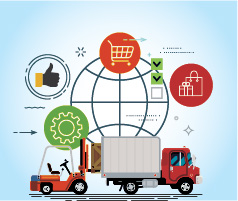
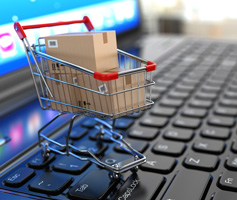
eCommerce Fulfillment: The Key Enabler for Multi-Channel Retailing
Global Business to Consumer eCommerce sales has witnessed a sharp growth over the last few years. According to eMarketer, eCommerce sales will top $4.058 trillion in 2020 i.e. 14.6% of total retail sales of US$ 27 Trillion.
Critical to enabling this growth is eCommerce fulfillment. As internet retailing grows, the needs and demands of multi-channel retailing continue to evolve. Clearly, there is a significant need for logistics in many emerging markets and for reliable service providers who can scale up to meet these burgeoning demands. eCommerce fulfillment is an opportunity area for established 3PLs globally as well.
The growth in internet retailing has created multiple new revenue streams for the eCommerce ecosystem. Some interesting trends include:
CPG companies selling to customers directly online
A clear trend is emerging wherein CPG companies are reaching customers online as an additional sales channel while taking care to not upset the existing partner network. This could be through setting up their own website or by selling through marketplaces as an additional channel or a combination of both. Given that most technology systems of CPG companies are predominantly B2B oriented, the fulfillment is being undertaken either by B2C 3PLs or by special purpose fulfillment centers set up by the CPG Companies.
eTailers leveraging cross-border sales and fulfillment
eTailers are partnering with marketplaces in multiple countries and cross-border platforms to reach global customers cost effectively. There is a clear trend to leverage B2C 3PLs for managing the deliveries and returns to diverse geography customers cost effectively.
Retailers selling online strategically
Retailers are using a mix of internal and external strategies to stave off completion from other eCommerce players like marketplaces and eTailers. These are:
- Using Internal Omni-Channel Strategies to deepen relationships with customers, providing a consistent experience across offline and online channels. Customers look for extra convenience to buy online, pick up from a store; reserve and collect, inventory lookups, buy online return in store, buy in one store and return in the other etc.
- External Strategies by retailers expanding through cross-border sales, selling on partner marketplaces and for the fulfillment of marketplace orders through inventory in stores.
Technology challenges include integration to multiple marketplaces, Real-time view of inventory, integrations with 3PLs to cost effectively deliver or to create special purpose warehouses for eCommerce fulfillment.
Growth of B2B eCommerce
B2B Commerce is expected to grow to US$ 1.2 Trillion revenues by 2020. “B-to-B buyers’ prior experiences with B-to-C digital commerce are creating high expectations for those buyers when making online B-to-B purchases i.e. customers rely regularly on the Web to research and buy from their favourite retailers, expect to be able to do the same when they show up at work and go about restocking the office supplies, storage room or maintenance shop.
Impact of Internet Retailing on Supply Chain Processes
In a traditional Supply chain, goods move from a factory warehouse to international warehouses, distribution centers throughout the world and directly to the stores. Typically the international warehouses handle huge pallets of single products that have to be unpacked and shipped to their respective destinations.
Now, if a retailer wants to ship each product/pack of products directly to the customer, the easiest way to do that is from the store. To cost effectively do this, it is necessary to develop supply chain processes suited for the online customer and to have warehouses either demarcated for eCommerce deliveries or special purpose vehicles be created. It is recommended that Retailers and CPG companies set up separate eCommerce fulfillment hubs or work strategically with 3PLs focused on eCommerce fulfillment.
Impact on choice of IT Systems – Choose a WMS system Designed for eCommerce Fulfillment
It is critical to choose a WMS (Warehouse Management System) designed for eCommerce fulfillment. Some of the key features to pay attention include:
- Ready Integration to marketplaces. This is a clear need for faster onboarding of customers. This requires that the Warehouse Management System used by the 3PL or the eCommerce fulfillment center is integrated with partner marketplaces.
- It is also critical for the 3PL to be integrated with partner 3PLs and Logistics service providers to be able to widen the geographical reach and manage deliveries and returns cost effectively.
- Client Wise Segregation of Inventory. The WMS solution needs to allow ‘client wise segregation of inventory’ critical to ensure effective end-to-end business process management.
- Batch Picking, Product Sorting, and Order Consolidation. While dealing with offline orders, large size orders can be categorized to consolidate the same items whereas, in Direct to Consumer orders, most small orders will be unique. Thus, a WMS system must enable picking of several units of mixed SKUs in a single pass through an aisle, maximizing the pick quantities, operational efficiency and reducing the travel time.
- 3PL Billing. 3PL businesses or Retailers/ CPG businesses who have invested in B2B fulfillment, often have a fixed billing scheme. An organization therefore, pays for a fixed booking for a long period. The fluctuations of inventory in eCommerce fulfillment, however renders fixed billing an ineffective option. This is a clear need for a flexible WMS system to manage the space – a system that not only handles the transactional based / periodic billing in an effective and timely fashion but is also robust enough to include miscellaneous charges as and when required.
- 3PL Portal. Real time information of orders, inbounds, transactions and time of delivery is a critical expectation of online customers. Management of this information from a single screen, without the hassle of constant support from a representative, greatly smoothens the customer’s experience. This self–service capability if built into the WMS, not only enables customer retention but also greatly reduces the time and expense invested into customer support.
Conclusion:
- Avoid trying to adapt your B2B Supply Chain to meet eCommerce fulfillment needs. Develop Supply Chain processes designed for eCommerce fulfillment/ work with 3PLs who are specialists in eCommerce fulfillment
- Develop partnerships with multiple 3PLs, Last-mile fulfillment and Logistics service providers for cost-effective deliveries and returns management
- Choose warehouse systems designed for eCommerce fulfillment and pay attention to a ready availability of marketplace and 3PL integrations. This will provide significant time to market advantage.
Read in detail, how eCommerce fulfillment enables Multi-Channel Retailing: goo.gl/NR2Axr
To know how our cloud-based suite of products helps brands and 3PLs undertake eCommerce Fulfillment: Visit or Contact Us
Any tips or questions about this post? Leave them in the comments below
Read MoreLion Parcel conquers MultiChannel Fulfillment with Vinculum’s Cloud-based Solution
All about Lion Parcel:
With a growing network of over 238 aircrafts, flying to more than 137 destinations through six airlines, Lion Air Group is Indonesian market leader in the aviation industry.
Lion Parcel (PT Lion Express) is express courier arm of Lion Group, one of the largest airline company, serving both domestic and international markets. As a member of Lion Air Group, they leverage Lion Air’s aircraft fleet, widest network of destinations, and quality of service to become a leader in the logistics industry. They are committed to developing its network and services performance to deliver the certainty and security of goods and documents.
Key Challenges:
Lion Parcel required a solution to help them optimize their operations. In order to scale up their business, they required a solution that would:
- Manage inventory of 1000+ SMEs. This required system integration with all sales channels – online (web stores, marketplaces) and offline (brick n mortar stores)
- Support offline store operations; Update orders & customer details in real-time using a POS system.
- Allow real-time visibility and tracking of inventory across channels and locations.
- Provide route management and order booking by integrating with an existing TMS.
The Vinculum Solution:
Vinculum’s SaaS-based product Vin eRetail helped Lion Parcel automate their operations and provide an effective and efficient logistics solutions to their clients. Our cloud-based solution delivered the following:
- Real-time view of Inventory to Clients through Client Portal and push notifications
- Integration with offline and online sales channels for fulfilling orders easily
- POS system to streamline retail stores’ order fulfillment process
- Easy order & inventory management using a single system
- Automated procurement systems to never run out of inventory, increase efficiency and deliver orders on time
Implementation of Vinculum’s Vin eRetail Suite helped Lion Parcel easily manage their warehouses/fulfillment centers and automate their operations. The seamless connectivity with all sales channels helped Lion Parcel undertake eCommerce fulfillment and increase their operational efficiency.
Read the complete story here.
Any tips or comments for us? Let us know in the comments below.
Read More

O2O for eTailers: How to deliver the OmniChannel Experience to Your Customers
“I think eCommerce for many years was an interesting trend, but it was on the side, largely, of what was happening in retail. Today we don’t even know what eCommerce means. They’ve just come together, the online and the offline. Now, every merchant, every retailer must have an OmniChannel strategy or they won’t survive.” – Devin Wenig, President, eBay Marketplaces
Today’s shoppers are always connected. They want to browse Online, research Offline, chat with a sales associate in the store to add to their knowledge, touch and feel the merchandise in the store, pay from an e-wallet, get the purchase delivered home, picked up from a store/nearby location, reserved at a location of their choice and enjoy same or near same day delivery.
Source: Forrester Consulting Research
Customers expect convenience in shopping and flexibility in order delivery like never before. In this scenario, OmniChannel is no more an option for Online brands; “Omnipresence” is an immediate imperative.
O2O (Online to Offline) can provide Online brands the means to provide a seamless experience to their customers, across multiple channels, like mobile apps, online store, etc. and brick and mortar store as well.
In an attempt to establish touchpoints for customers to touch and feel their merchandise, Online brands and marketplaces are going Offline. The touchpoints can be in the form of collection centers, express retail stores and vintage locations, e.g. shopping malls
Interestingly, Online brands and marketplaces are trying various means to court customers including:
- Offering extra conveniences –Buy Online, pickup in store; Cash on Delivery, Reserve Orders, and Payment through Credit/Debit Cards or eWallets etc. have emerged as an important strategy to provide convenience to customers. Customers look for this flexibility as they do not have to wait at billing counters, keep cash, wait for deliveries, travel to a distant store or pay shipping charges.
- Setting up kiosks in departmental stores, shopping malls. Collaborating with retailers by working in conjunction with them for trials in stores etc. Several eTailers are now going for hybrid retailing, which is a mix of Online and Offline channels. The companies are opening kiosks/franchisee outlets and tying up with retailers. This model not only helps eTailers increase their sales, it also eliminates worries about shipping, logistics and warehousing costs and challenges.
These are fulfillment options gaining popularity with online stores and shoppers alike. They allow a shopper to buy online and then collect the purchase from the store. Retailers like Argos etc. are not considered as competitors anymore, but partners in a win-win strategy.
The Offline – Online – Offline continuum throws up multiple collaboration opportunities for the entire ecosystem.
- Sell on multiple marketplaces: Online brands and Brick n Mortar retailers can sell their items on a partner marketplace like Amazon, eBay, Flipkart etc. Many brands & SMEs have built a business model to grow domestically and internationally by selling on multiple marketplaces.
- Retailers as a fulfillment partner: As customers shop Online on eStore or marketplaces like Amazon, Ralali, Nykaa etc. – they see options for regular delivery or pick up from the store. Additionally, if the location of the store is close to the customer, the order can be directly shipped to the customer to save on time and logistics cost.
In both the scenarios the key to facilitating this is having a real-time view of the inventory in the partner store and integrations of store systems with eCommerce system to ensure they have this information.
- Sell Cross-border: SMEs, Online brands, retailers and CPGs, all have the opportunity to not only reach customers domestically but also internationally, across multiple countries so long as the cost of the products along with shipping costs allows them to sell profitably.
There are many shipping platforms today which facilitate item handling, customs management and local deliveries in multiple countries which allow you to sell on your web-stores or on marketplaces. Already, many SMEs use this model to sell extensively across continents. Cross-border is poised to grow and the smart multi-channel retailer will exploit the opportunities to collaborate with 3PLs and marketplaces to grow their revenues.
How can Technology help you achieve O2O transformation?
A typical Online brand (eTailer) makes investments in the following systems:
- Order Management Systems: To manage and streamline orders across channels.
- Warehouse Management Systems: For B-B and B-C eCommerce fulfillment.
While the respective building blocks are best of the breed in their domain, they are not geared to meet the functionality/flexibility required to support additional sales channels. Thus, Some of the key areas to address include:
- Real time update and synchronization of inventory between both online and offline channels
- Fulfillment of online orders from single/ multiple partner stores
- Online tracking of all the orders
- Consistent information across channels and applications
- Cloud POS to set up express stores or kiosks, order to easily support their small stores.
The basic requirement for enabling offline operations is to collaborate with retail chains or setup your own kiosks/small stores. The next step is the implementation of different pieces in the O2O suite to ensure a smooth integration with ERPs, 3PLs, store systems, eCommerce front-ends, and/or marketplaces.
Vin eRetail O2O Suite, with its ready integrations with 75+ leading global web stores, marketplaces, and last-mile fulfillment companies, provides a complete set of solution to enable the online to offline transformation.
To know more – Request a demo today!
Any tips or comments for us? Let us know in the section below.
Read MoreIndustry Speak – urDOORSTEP.com
“Online grocery sales set to surge, grabbing 20 percent of the market by 2025” according to a report by the Food Marketing Institute (FMI) and Nielsen.
Dinesh Malpani, CEO & Founder, UrDoorstep, was able to foresee such a big transformation which is going to happen in India & across the globe for Online food & grocery business. In his journey in the retail industry, Dinesh has seen food & grocery in almost all avatars across different geographies.
In this video, Dinesh talks about how he started his venture, tapped this large business opportunity – online grocery and is successfully running this business.
About UrDoorStep:
urDOORSTEP.com is India’s first online hypermarket, redefining the retail industry by not just delivering the widest range of quality products at your doorstep, but also adding value to every step of the process, thereby taking online shopping to a whole new level.
About Dinesh Malpani (CEO & Founder, UrDoorstep):
Dinesh‘s exhaustive 25 years of experience and his in-depth knowledge in the multi-channel Retail & eCommerce Industry helped the company offer the best possible experience and value to their customers. His ability to analyze the market, understand the behavioral patterns and cater to the changing demands of the highly dynamic retail business, makes him a visionary and innovative entrepreneur who is all set to revolutionize online retail with urDOORSTEP.com.
Dinesh says “In the food & grocery business, the backend, the warehouse, the procurement of inventory, order management, picking, packing & shipping are the lifelines of this business,”
To know more: https://goo.gl/KibNbU
Any tips or questions for us? Leave them in the comments below.
Read More

Vin eRetail among the best WMS software for Retail & eCommerce
Geoff Whiting is an experienced journalist, writer, and business development consultant with a focus on enterprise technology, e-commerce, and supply chain development. Working with ExploreWMS, Geoff outside the office he can be found toying with the latest in IoT, searching for classic radio broadcast recordings, and playing the perpetual tourist in his home of Washington D.C.
He says “If you see an e-commerce business owner with missing patches of hair, it’s because their warehouse management system doesn’t always work with their order channels.”
“A good WMS can help your e-commerce retail business avoid all of that by automating the process and creating documents that are easy to audit.”
In his article, published on ‘the best WMS software for e-commerce retailers’ Geoff features Vinculum’s Vin eRetail WMS as one of the top WMS solutions for its B2B warehousing and B2C eCommerce fulfillment.
He writes “Our representative for the e-commerce fulfillment center focus in the Vin eRetail WMS from Vinculum. This platform focuses on fulfillment for both the B2B and B2C side with a wide range of automation tools, support for segregating multi-client inventory, and operating in multiple locations or with multiple currencies.
It has perhaps the most robust real-time inventory tools on our list and it delivers that transparency for vendors and customers. The platform also features a variety of quality control tools and multiple scanning and RFID support options. It odes integrates with a lot of web marketplaces but also works well with retail and manufacturing partners and ERPs.
Customers all seem to enjoy the robust toolset that can be accessed through a single platform, but they note that the user interface needs some work. It gets the job done, even if it isn’t the prettiest thing doing it.”
Vinculum’s Vin eRetail has been featured in Gartner’s Magic Quadrant for Warehouse Management Systems,
“Vinculum has a unique position in the market helping to enable multichannel fulfillment across a network of 3PLs, consumer goods companies, retailers, e-commerce companies, marketplaces, and sellers”
“Vinculum’s cloud/SaaS solutions offer a unique ability to connect with multiple marketplaces to support multichannel fulfillment”
Vinculum’s Vin eRetail WMS is a Warehouse Management System designed for B2B & B2C fulfillment.
Benefits of Vin eRetail Warehouse Management Solution include:
- Ready Integration with leading marketplaces, webstores, and last-mile fulfillment companies
- Real-time view of inventory across multiple warehouse locations
- Easy Fulfillment of Orders from multiple warehouses across borders
- Segregation of Inventory for multiple clients and visibility using Client Portal
- Automated and Mobile enabled warehouse operations
- 3PL Billing
- Low Total Cost of Ownership
To Know more: https://goo.gl/Ltn01c
Read More
Pamalees collaborates with Vinculum to accelerate its OmniChannel growth
All about Pamalees:
Based in Hong Kong, Pamalees was founded in 2012 with an objective to offer complete sourcing solutions to retailers, wholesalers, distributors, and manufacturers. With operations in major countries of Asia and Middle-East, what differentiates Pamalees is the wealth of experience & retail lineage carried forward by the founders and their dedication to maximize customers gain via thorough, fair, and profitable activities.
Pamalees Limited, operates two online businesses – a B2B business (Pamalees F&C Corporation), and a B2C business, L’epicerie Gourmand. Their brick and mortar store is also a restaurant where French preparations are served. Inventory used in the kitchen is also available for sales to customers.
Currently they are working on a business model where they import goods from France and sell in the Philippines market.
Key Challenges:
Pamalees forayed into the Philippines market with their assortments of wines, groceries, health & beauty products. They required an end-to-end solution to launch their B2B & B2C online portals and manage the multichannel operations. Also, they needed a solution to –
- build their B2B & B2C sites and manage their webstores.
- manage all the orders, inventory and returns across offline and online stores
- seamlessly integrate their brick n mortar stores with head office and online store systems
- manage and support store operations
- implement Philippine-specific promotions while complying with local laws
- integrate store system with weighing scale
The Vinculum Solution:
Vinculum is helping them deliver a successful Omnichannel experience to their customers through our end-to-end implementation of O2O suite. The offering included –
- Implementation of Magento based webstores for their B2B & B2C Online portals
- A SaaS-based solution, single interface to manage all the orders, inventory & returns.
- MultiChannel Order & Inventory management
- Seamless Integration of Online & Offline stores systems
- Integration with Payment gateway eGHL
- Customized stock adjustment reports
- Defining the flow of master data from one system to another
Implementation of Vinculum’s O2O suite helped Pamalees expand their business footprints in eCommerce & brick & mortar channels easily.
We continue to work with them to help them grow across channels and scale new heights.
Any tips or questions for us? Leave them in the comments below –
Read More


How to Ace- The eCommerce Space
Global Business to Consumer eCommerce sales has witnessed a sharp growth over the last few years. According to eMarketer, online retail is estimated to reach US$ 4.058 trillion in 2020, i.e. 14.6% of the overall retail sales of US$ 27.7 trillion.
These are both tough yet exciting times for an online business these days. With growth in the eCommerce space comes ever increasing competition & a more online savvy customer base means it can feel impossible to keep up with consumer demands. Customers are becoming more self-aware & about the online space with tons of information about any product, even the smartest of businesses can learn a lot from their own user base OR lose them to competition.
If you are constantly feeling challenged to keep your customers happy & be profitable at the same time, you are not alone! These are a few challenges, online businesses face:
1) Expanding your reach (Selling on Marketplaces): When selling just from your website is not enough or when your business matures to a level where you feel the need for expanding your reach, partnering with marketplaces and selling on them makes perfect sense. It does however come with its own set of challenges. Which marketplaces to sell on – Etsy, Amazon, eBay…or all of them? How to manage orders & returns across marketplaces?
An eCommerce/Multichannel Order Management software can help. Integrations to eCommerce Marketplaces & eCommerce front-ends (like Shopify, Magento, Prestashop etc.) should be seamless & real time. Not only should it ensure your inventory info is accurate across multiple online channels to prevent out of stocks it should also help keep pricing consistent. eTailers are partnering with marketplaces in multiple countries and cross-border platforms to reach global customers cost effectively. There is a clear trend to leverage B2C 3PLs for managing the deliveries and returns to diverse geography customers viable. A direct integration to major shipping (eg. DHL, Delhivery, DTDC, UPS, USPS etc) & last-mile fulfillment companies to help you fulfill your orders both domestically & cross-border.
2) Single view of your business for operational efficiency: Typically, with order volumes and new channels being added to your business, the complexity to manage operations, increases exponentially. Online retailers are now already investing time and money to turn customers into loyal repeat buyers. But often, it’s how well quickly the merchant processes the order, ships it & later handles returns of online orders -that is the deciding factor in maintaining loyalty. Older/repeat customers are usually the most difficult to keep happy.
You should have the operational efficiency to either manually or through an OMS – manage huge volumes of holiday-season orders & be flexible enough to process “channel- specific” returns. A single dashboard view of your Orders & Returns (across channels) & customers is a hygiene factor & keeping track of customer issues resolution & trouble-ticketing, a necessity.
3) Managing customer expectations:
Besides discounts, customer returns & cart abandonment are the 2 major headaches for any eCommerce business. As mentioned earlier, your ability & time taken to process these returns & provide credit to the customer is a ticking bomb. Ensure you have processes & systems in place to keep them happy & make them come back to you.
Cart abandonment – many reasons why this happens: Complicated checkout process, slow shipping, lack of payment systems & most important- inaccurate/misleading product information.
Inconsistent product information is more often than not, the underlying reason for both cart abandonment & returns.
Customers these days research before they shop & the easier you make product discovery, more likelihood that they will complete the purchase. While customers search, inaccurate product descriptions, lack of availability, confusing/unstructured catalogs, lack of filtering options are a big deterrent and an irritant. Other factors which influence the discovery to purchase journey is, of course, your Site/cart design, payment flexibility & delivery options.
How can we help? Watch this video to know how we help Turbocharge your online business, here
Vinculum Solutions is a Global SaaS-based enabler for the eCommerce ecosystem that helps simplify Multichannel Order Management & Fulfilment.
- Our Ready Integrations with Global Marketplaces, webstores, 3PLs and last-mile fulfillment companies, help brands sell across borders and fulfill effectively
- Single Interface to manage all your orders, inventory and returns across channels
- Manage Dropship Orders Easily to directly
- Manage your warehouses, returns and sellers/suppliers efficiently
To know more: https://goo.gl/uTG5dk
Read More
